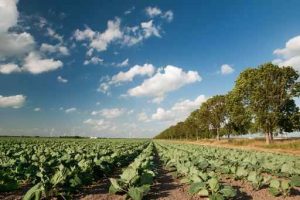When you look at a farmer’s field full of cauliflowers, all fat and looking wonderful and then look around the average allotment site’s offering you have to wonder what the farmer knows that we don’t.
The fact is that the farmer makes his living from his crops and invests in getting the best possible yield. First of all the farmer needs to know what the optimum nutrient supply for the crop should be, so he has the soil analysed to find out what is already there in his ground. From this starting point he calculates what he is going to need to add and decides how to add it.
The average gardener or vegetable grower isn’t going to spend out for a laboratory soil analysis and there is an argument that providing the optimum nutrition for growth doesn’t provide necessarily produce the best flavour either. High nitrogen supplies also tend to produce lush growth, beloved by aphids, so our pest problems can be made worse by too much fertiliser use.
Over-use of fertilisers is, from the farmer’s point of view, a waste of money as there is no benefit to it. It can also cause environmental problems, causing algal blooms in streams and rivers.
Having said all of that, starving our plants is not going to produce good results and it’s worth looking at what the nutritional requirements of our plants are and how we can supply them. Before we do that, it’s important to understand what the components of fertilisers are and what they do – see What the NPK Means in Plant Fertiliser
Different fertilisers will provide different percentages of various nutrients so the quantity added will depend on the content. For example, if you want to add 10g of nitrogen per square metre you would need to add 83g of dried blood (12% nitrogen) or 50g of sulphate of ammonia (20% nitrogen) but if you wanted to supply that nitrogen from cow manure you would need 1,660g at its average 0.6% supply.
Of course, your cow manure will supply valuable humus that the fertilisers will not. There’s more information on the NPK Values of Common Manures and Composts
Unlike artificial fertilisers, the ‘natural’ fertilisers tend to dissolve slowly and thereby release their nutrients more slowly. More information on natural fertilisers.
Artificial Fertilisers
These are manufactured chemicals or sometimes mined and processed minerals. They are not usually approved for use in organic systems but they do not have any potential risks like pesticides to humans. More information on artificial fertilisers.
Straight fertilisers are those that purely supply one element, like sulphate of ammonia or urea
Straight Artificial Fertilisers:
| N Nitrogen % | P Phosphorus % | K Potassium (Potash) % |
|
|---|---|---|---|
| Sulphate of Ammonia | 20 | ||
| Prilled Urea | 46 | ||
| Nitro Chalk | 27 | ||
| Nitrate of Soda | 16 | ||
| Sulphate of Potash | 50 | ||
| Superphosphate | 18.5 | ||
| Rock Phosphate | 26 | ||
| Triple Superphosphate | 45 | ||
| Basic Slag | 10 |
Compound Artificial Fertilisers
Compound artificial fertilisers are produced by combining straight fertilisers in various proportions to form balances suitable for general growing or for specific crop requirements.
| N Nitrogen % | P Phosphorus % | K Potassium (Potash) % |
|
|---|---|---|---|
| Growmore | 7 | 7 | 7 |
| Vitax Q4 | 5.3 | 7.5 | 10 |
| J I Base | 5.2 | 7.7 | 10 |
| Chempack BTD | 6 | 8 | 10 |
| Hydro Complex | 12 | 11 | 18 |
| Generic potato fertiliser | 7 | 5 | 12 |
Many more compound fertilisers are available, often balanced to provide the NPK ratios favoured by specific crops such as tomato foods and incorporating various trace elements.
Trace Elements & Micro-Nutrients
Just as people need vitamins and minerals in their diet for long term health, plants require other elements in their diet to thrive. Many of the compound fertilisers add these trace elements just as vitamins are added to some of our foods. These other elements are covered in Additional Elements of Plant Nutrition and in Trace Elements or Micro-Nutrients of Plant Nutrition
Having covered the range and types of fertilisers available let’s take a look at some specific plant requirements and how we can meet them The main element for growth is nitrogen. Nitrogen is vital to the production of the leaves, which in turn power the plant’s growth and the more leafy growth a plant produces the more nitrogen it will require.
Because nitrogen has the shortest life in the soil, being easily washed out by heavy rain for example, it is the one element to concentrate on and with crops that are in the ground for a long time worth applying in stages rather than one go.
Nitrogen Requirements of Various Crops
| Very High Nitrogen Requirement | High Nitrogen | Medium Nitrogen |
|---|---|---|
|
|
|
| Low Nitrogen | Very Low Nitrogen |
|---|---|
|
|
Remember that legumes produce much of their own nitrogen due to a symbiotic relationship with bacteria that fix nitrogen from the air for the plant, which is why peas and broad beans generally need little to no nitrogen supplement and runner beans with all their foliage need just low levels to supplement their own produced nitrogen.
Specific fertiliser requirements and feeding plans for some vegetables are listed below:




